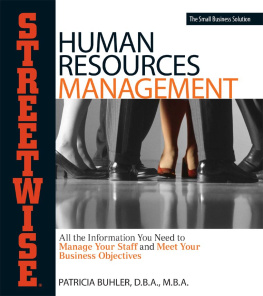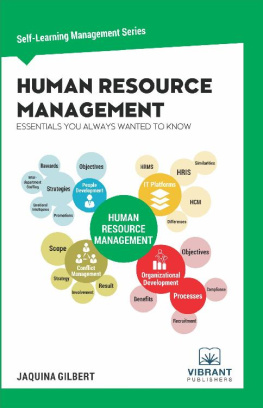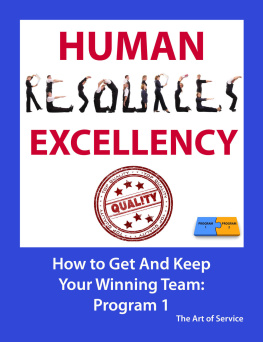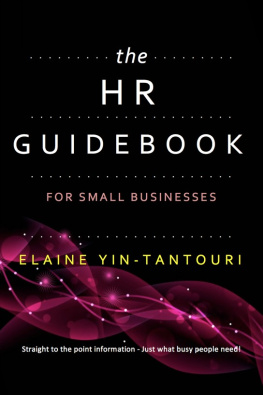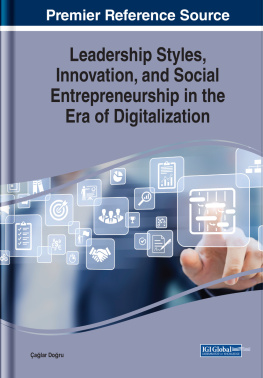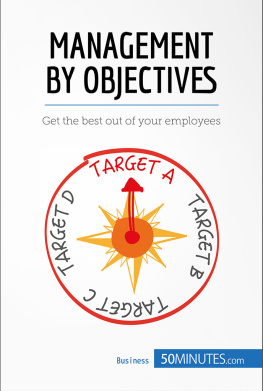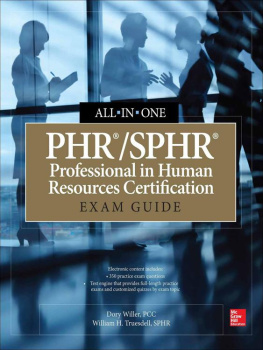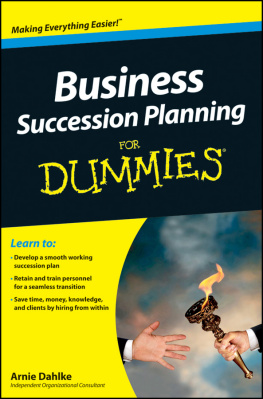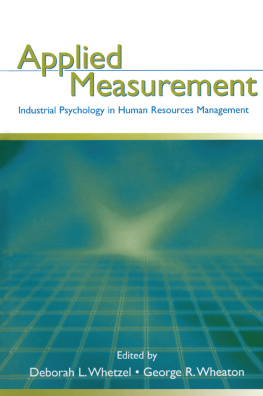Copyright 2002, F+W Publications, Inc. All rights reserved.
This book, or parts thereof, may not be reproduced in any form without permission from
the publisher; exceptions are made for brief excerpts used in published reviews.
A Streetwise Publication.
Streetwise is a registered trademark of F+W Publications, Inc.
Published by Adams Media, an imprint of Simon & Schuster, Inc.
57 Littlefield Street, Avon, MA 02322. U.S.A.
www.adamsmedia.com
ISBN 13: 978-1-58062-699-6
ISBN 10: 1-58062-699-8
eISBN 13: 978-1-44051-942-0
Printed in the United States of America.
J I H G F
Library of Congress Cataloging-in-Publication Data
Buhler, Patricia M.
Streetwise human resources management / Patricia Buhler.
p. cm.
Includes.
ISBN 1-58062-699-8
1. Personnel management. I. Title: Human resources management. II. Title.
HF5549.B8736 2002
658.3-dc21 2002005580
This publication is designed to provide accurate and authoritative information with regard to the subject matter covered. It is sold with the understanding that the publisher is not engaged in rendering legal, accounting, or other professional advice. If legal advice or other expert assistance is required, the services of a competent professional person should be sought.
-From a Declaration of Principles jointly adopted by a Committee of the
American Bar Association and a Committee of Publishers and Associations
Cover illustration by Eric Mueller.
This book is available at quantity discounts for bulk purchases.
For information, call 1-800-289-0963.
CONTENTS
CHAPTER 1
The Environment of Human Resources Today
CHAPTER 2
The Legal Environment
CHAPTER 3
The New Role of Human Resources
CHAPTER 4
Skills for Effective Human Resource Management
CHAPTER 5
Human Resource Planning
CHAPTER 6
Recruitment
International Recruitment:
A Special Challenge in a Global Arena
CHAPTER 7
Selection: The Steps to the Decision to Hire
CHAPTER 8
Orientation: The Acculturation Process
CHAPTER 9
Training and Development
CHAPTER 10
Job Analysis
CHAPTER 11
Job Design
CHAPTER 12
Motivation: The Old and the New
CHAPTER 13
Appraising Performance
CHAPTER 14
Compensation and Benefits
CHAPTER 15
Retention Strategies
CHAPTER 16
Downsizing, Layoffs, Restructuring, and New Organizational Structures
CHAPTER 17
Safety, Health, and Privacy Issues
CHAPTER 18
Diversity
APPENDIX A
Helpful HR Tips and Quick References
APPENDIX B
Selected Excerpts from Major Legislation Impacting Human Resources
APPENDIX C
Forms and Applications
APPENDIX D
Glossary
H uman resource planning is a key initial step in getting the right people in the right place at the right time. Without accurate planning, the organization may not be positioned to compete effectively in the marketplace. This proactive process anticipates future staffing needs by forecasting the supply and demand of the firms human resources.
Effective human resource planning will save the organization considerable money. The organization cannot afford to be overstaffed or understaffed because it will incur additional costs. If the company is overstaffed, it is paying for workers who are not being challenged to their fullest capacity. If it is understaffed, productivity and quality may suffer because not enough people are available to perform the work effectively.
Those organizations that fail to engage in human resource planning also impact the career development of their employees. Employees who have no knowledge of their firms staffing plans may seek employment elsewhere to further their careers. Companies incur significant costs when employees are unhappy with their career development and leave the organization to work for the competition.
Employees who have no knowledge of their firms staffing plans may seek employment elsewhere to further their careers.
The Role of Strategic Human Resource Planning
The planning function of human resources (traditionally referred to as manpower planning) drives all the other functions. Staffing needs must be identified before other functions can be addressed. Once the staffing plans are completed, then the remaining human resource functions can be integrated into a cohesive plan. The strategic human resource planning process drives the other human resource management functions, from recruitment to training and development.
Human resource planning is the organizational process used to determine how people will be hired and used in the firm. To be the most effective, this process should be ongoing, and it requires foresight. The planning process is concerned with all aspects of the employment function: recruitment, selection, compensation, training, job design, and advancement. These functions in turn support organizational performance.
Human resource planning assists the organization in meeting its strategic objectives. By projecting the firms human resource needs, the appropriate people can be identified, hired, promoted, transferred, and/or trained. As a result, the right people will be in the right job at the right time.
Effective human resource planning builds in flexibility and enables the organization to change in response to the environment. The plan should not to be so rigid that adjustments cannot be made as environmental changes occur. A certain amount of flexibility is needed to take advantage of opportunities as they become available or known to the organization.
Effective human resource planning builds in flexibility and enables the organization to change in response to the environment.
The firms overall strategy provides the framework and the destination for this human resource plan. The human resource plan will provide answers to questions such as the following:
How many people will be needed for the organization to meet its objectives?
What jobs will these people need to fill?
What knowledge, skills, and abilities will new hires be required to have?
What new skills will be required of the current work force?
Can these new workers be transferred or promoted from within the firm or do they need to be hired from outside?
What type of training is required for workers to acquire the knowledge, skills, and abilities that are needed?
What type of compensation plan is required to support this talent?
How will this process alter the career plans of existing employees or potential candidates?
There is a two-way relationship between human resource planning and strategic planning. That is, the plans influence and support each other. In most organizations today, the processes of human resource planning and strategic planning have become closely integrated. Human resource planning helps the organization craft a feasible strategy that makes sure people are available with the appropriate skills to pursue the strategic objectives. Human resource planning again plays a major role when the strategy is implemented to ensure the firms human resources are appropriately allocated to effectively implement the strategy as designed. Human resource policies must reinforce the firms strategic objectives and must be closely aligned with one another.
If the external environment cannot provide the necessary supply of key workers, the human resource plan may need to be altered.

